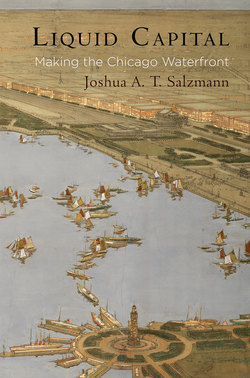Liquid Capital

Реклама. ООО «ЛитРес», ИНН: 7719571260.
Оглавление
Joshua A. T. Salzmann. Liquid Capital
Отрывок из книги
LIQUID CAPITAL
Series Editors:
.....
In the 1830s, the Army Corps of Engineers cut a channel through the sandbar at the mouth of the Chicago River, forever altering the shoreline in unforeseen ways. To open the harbor, Howard suggested to Congress that the Army Corps of Engineers cut a channel across the sandbar, so that the Chicago River flowed due east into the lake. Howard proposed building two long piers on either side of the river mouth that extended out into Lake Michigan, thereby, Howard hoped, protecting the river’s opening from sand.58 In 1833, Congress appropriated money. Army engineers, first commanded by Major George Bender and after 1834 by Lieutenant James Allen, cut a two-hundred-foot-wide channel through the sandbar so that the river flowed almost due east into Lake Michigan about one thousand feet north of its former outlet. By 1835, the south pier ran 700 feet into the lake and the north, or weather, pier extended 1,260 feet. Lieutenant Allen could already see that just north of the weather pier, a new sand bar was forming that threatened to encroach on the river channel as it grew. As the lake currents rolled in from the northeast, the north pier trapped sand, growing the north shoreline of the city by 320 feet between 1833 to 1837 and another 400 feet between 1837 and 1839, creating an area known as the “sands” and later Streeterville. South of the piers, however, the effect was just the opposite. The piers prevented the currents from depositing new sands and created an eddy that eroded the existing southern lakeshore, an area occupied by the U.S. Army Fort Dearborn and the city’s only public parks.59
The city of Chicago acquired the valuable but eroding Fort Dearborn lands from the federal government in 1839. By 1833, American forces had crushed the band of Sauk and Fox Indians led by Chief Black Hawk and forced Native Americans to relinquish their lands east of the Mississippi River.60 Fort Dearborn, therefore, became largely obsolete except that it housed the army engineers who worked to clear the mouth of the Chicago River. In 1838, Chicagoans petitioned the federal government to relinquish the fort because it was “useless for a military post.”61 In 1839, the Secretary of War granted 90 percent of the Fort Dearborn land to the city, reserving only a small parcel south of the mouth of the Chicago River for military buildings. The Fort Dearborn Addition to Chicago consisted of valuable waterfront lots and public lands. The addition consisted of seventy-six acres extending northeast from the intersection of State and Madison Streets to Lake Michigan and the Chicago River, most of which the city subdivided into lots and sold to private parties.62
.....